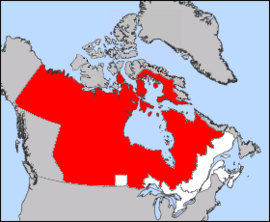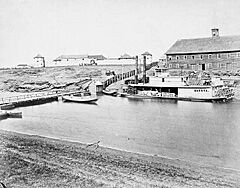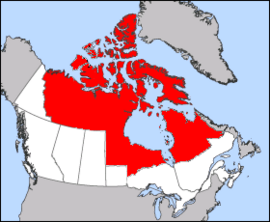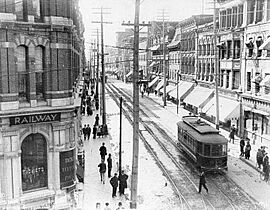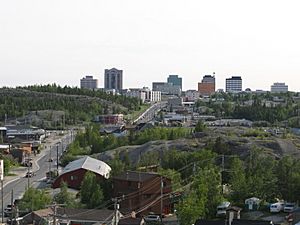History of Northwest Territories capital cities facts for kids
| Northwest Territories capitals | ||
|---|---|---|
 |
||
| City | Years | |
| Fort Garry | 1870–1876 | |
| Fort Livingstone | 1876–1877 | |
| Battleford | 1877–1883 | |
| Regina | 1883–1905 | |
| Ottawa | 1905–1967 | |
| Fort Smith | 1911–1967 | |
| Yellowknife | 1967–present | |
The history of Northwest Territories capital cities is a long and interesting story. It began when Canada bought the land from the Hudson's Bay Company in 1869. The Northwest Territories is special because it has had seven different capital cities!
The government moved its main office for many reasons. Sometimes it was because of conflicts, or to build better roads and buildings. The borders of the territory also changed a lot over time. These changes made it hard for the government to serve everyone. The territory is very big and its shape kept changing.
The word "capital" means the city where the main government office is. This includes the Legislative Assembly of Northwest Territories, which makes laws. Usually, the administrative offices (where daily work happens) are in the same city. But the Northwest Territories was different. From 1911 to 1967, it had its law-making office in one city and its administrative office in another. No other Canadian province or territory has done this.
Contents
- Fort Garry: The First Capital (1870–1876)
- Fort Livingstone: A Temporary Stop (1876–1877)
- Battleford: A Step Towards Self-Rule (1877–1883)
- Regina: A Growing Government (1883–1905)
- Ottawa: Governing from Afar (1905–1967)
- Fort Smith: The Administrative Hub (1911–1967)
- Carrothers Commission: Asking the People (1965-1967)
- Yellowknife: The Modern Capital (1967–present)
- Lessons Learned for Nunavut's Capital (1995 Vote)
- See also
Fort Garry: The First Capital (1870–1876)
In 1868, the Canadian government bought a huge area of land from the Hudson's Bay Company. This land was mostly wild and empty. The government decided to combine these lands into one big territory.
In 1869, William McDougall was chosen to be the first leader of the Northwest Territories. He went to Fort Garry to set up the government. But a group led by Louis Riel stopped him. They were upset about the land transfer to Canada. This led to the Red River Rebellion.
Because of the rebellion, the province of Manitoba was created. Fort Garry became part of Manitoba. In 1870, the Northwest Territories and Manitoba officially joined Canada. For a while, the two areas were still connected. A temporary council was set up in 1872. This council, mostly made of people from Manitoba, governed the Northwest Territories from Fort Garry.
This temporary government met every year. In 1875, the Canadian government decided to move the capital. They chose a new place inside the Northwest Territories. A smaller council and a new leader were appointed just for the Territories.
Fort Garry had two parts: Upper Fort Garry and Lower Fort Garry. After the territorial government moved, Fort Garry remained the capital of Manitoba. Today, Fort Garry is modern-day Winnipeg, the capital of Manitoba. Lower Fort Garry is now a historical site.
Fort Livingstone: A Temporary Stop (1876–1877)
A new law in 1875 created a permanent government for the Northwest Territories. This new government started on October 7, 1876. It met in Fort Livingstone, a small outpost in what is now Saskatchewan. Fort Livingstone was not a real city. It was chosen as a temporary spot until the route for the new railway was decided.
Fort Livingstone was built in 1875 by the North-West Mounted Police. This group later became the Royal Canadian Mounted Police, Canada's national police force. The police barracks at Fort Livingstone became the temporary meeting place for the government. It was also the office for the leader, called the Lieutenant Governor.
Most of the police moved away in 1876. A year later, the Lieutenant Governor, David Laird, moved the government again. This time, it went to Battleford. This decision was made because the Canadian Pacific Railway (CPR) was planned to go through Battleford.
Fort Livingstone was destroyed by a prairie fire in 1884. Today, the closest town is Pelly, Saskatchewan. The site of Fort Livingstone is now a historical marker.
Battleford: A Step Towards Self-Rule (1877–1883)
The Northwest Territories government moved to Battleford in 1877. Battleford was meant to be the permanent capital. It was chosen because it was expected to be connected by the Canadian Pacific Railway.
In Battleford, the territory made big steps towards governing itself. For the first time, people living in the territory could elect their own representatives. These elected members joined the appointed members in the assembly. The first election happened in 1881. Battleford also hosted the first royal visit in western Canada in 1881.
The first building made specifically for the Northwest Territories government was in Battleford. It was called "NWT Government House." The government used it until 1883. The building was a historical site until it burned down in 2003.
In 1882, the Lieutenant Governor, Edgar Dewdney, decided to move the capital again. This time, it went to Regina. This move was controversial. People were concerned because Dewdney owned land in Regina. They thought he might be making the decision for his own benefit.
Regina: A Growing Government (1883–1905)
Regina officially became the new capital on March 27, 1883. A new government building was started there. The government in Regina grew as the city got bigger. By 1902, the legislature had the most members ever in Northwest Territories history.
The government in Regina faced challenges. It was hard to provide services to such a huge territory. Many new settlers arrived, and the government also had to deal with the Klondike gold rush. They also argued with the federal government about having limited powers and money.
Over time, more power was given to the elected members. In 1897, elected members gained control of the executive council. This led to a brief period of political parties. Before this, the government used a "consensus model," where decisions were made by agreement.
In 1905, the leader of the territorial government, Frederick W.A.G. Haultain, made a deal with the Canadian government. This led to the creation of the provinces of Saskatchewan and Alberta. These new provinces were formed from the southern, more populated parts of the territory.
The Northwest Territories became much smaller. It went back to being controlled by the federal government. A new council was set up in Ottawa, Ontario, to manage this smaller territory. The old government building in Regina was restored in 1979 and is still standing today. Regina continued to be the capital of the new province of Saskatchewan.
Ottawa: Governing from Afar (1905–1967)
In 1905, the capital of the Northwest Territories moved to Ottawa, Ontario, Canada's capital city. This happened after Alberta and Saskatchewan became provinces. The Northwest Territories was left with very few people or towns. Only about 1,000 non-Inuit people lived there. Inuit people were not counted at the time.
From 1905 to 1921, there was no sitting council. The government was small but still active. A small group of civil servants went to Fort Smith in 1911 to set it up as the new administrative capital. The federal government still provided a small budget for basic services. During these 16 years, no new laws were made. The territory and its people were largely ignored.
The new council met for the first time in 1921. None of its members lived in the Northwest Territories. They were mostly high-level government workers who lived in Ottawa. The first person from the Territories to join the council was John G. McNiven in 1947.
Eventually, the Ottawa-based council became more aware of the needs of the territory's residents. Democracy returned in 1951 with the sixth general election. After this, the council began to hold meetings in different communities across the Northwest Territories. They met in school gyms, community halls, or any suitable building. They even brought their special Speaker's chair and mace (a ceremonial staff) with them.
When legislative sessions were held in Ottawa, they took place in an office building on Sparks Street. The Northwest Territories government still has an office there today. In 1965, a special commission was created to find a new home for the government. In 1967, the capital was moved back inside the territories to Yellowknife.
Fort Smith: The Administrative Hub (1911–1967)
Fort Smith became the main administrative and transportation center for the Northwest Territories in 1911. This was the first time in six years that the territorial government provided services there. These services included an agent for Indigenous affairs, a doctor, and a Royal Canadian Mounted Police station.
Fort Smith was chosen for its location and development. It was one of the few communities with steamboat service. This connected it to the railway in Alberta and to the vast waterways in the territory. It was the easiest community for the government to reach and the most developed, while also being closest to Ottawa.
Fort Smith housed the civil service until 1967. Even after Yellowknife was chosen as the new capital, Fort Smith continued to host many government workers. This was because the new capital did not yet have all the necessary buildings.
Carrothers Commission: Asking the People (1965-1967)
The "Advisory Commission on the Development of Government in the Northwest Territories" was created in 1965. It was often called the Carrothers Commission, after its leader, Alfred Carrothers. This commission was a big moment in the history of the Northwest Territories. Its job was to study and suggest changes for self-government in the North. One of its most important tasks was to choose a new capital city.
For the first time, the Carrothers Commission listened to the people of the Northwest Territories. They visited almost every community and talked to residents, leaders, and business people. Before this, decisions about the capital had always been made without asking the people. For example, Edgar Dewdney faced criticism when he moved the capital to Regina because he owned property there. When the government moved to Ottawa, people were upset because it was so far away.
The Carrothers Commission spent two years visiting communities. They looked at five places for the new capital: Hay River, Fort Simpson, Fort Smith, Inuvik, and Yellowknife. Many people thought Fort Smith would win because it already had the civil service.
Yellowknife: The Modern Capital (1967–present)
Yellowknife officially became the capital on September 18, 1967. The Carrothers Commission chose it for its central location, good transportation, industries, and the wishes of its residents.
In 1967, Yellowknife was not fully ready to be the capital. It took many years to build the necessary buildings and services. So, most of the civil service stayed in Fort Smith for a long time. The governing Council also continued to hold meetings in different communities across the territory.
A new building for the legislative council was finished in Yellowknife on November 17, 1993. This was the first building built specifically for the Northwest Territories government since the one in Regina 88 years earlier. The new building was designed with themes from Inuit culture. This showed that the government respected the Indigenous people living in the territory.
Today, the government in Yellowknife is strong and effective. It has gained back most of the powers it had before 1905, when Alberta and Saskatchewan were created. The civil service is now mostly in Yellowknife. The territory also controls its own elections and education. The federal government has even talked about the Northwest Territories becoming a province in the future.
As you've read, all seven capitals of the Northwest Territories were chosen by outside governments. However, the Carrothers Commission did ask the people for their opinions.
After Yellowknife became the capital in 1967, many people in the eastern Arctic felt they were not well represented. Groups were formed to fix this. Lessons learned from the history of the Northwest Territories' capitals helped create the new territory of Nunavut in 1999. Nunavut was formed from the eastern half of the Northwest Territories.
In 1976, during land claims talks, the idea of dividing the Northwest Territories came up. This would create a separate territory for the Inuit people. In 1982, people across the Northwest Territories voted on this idea. Most residents voted in favor of the division.
The land claims agreement was finished in 1992 and approved by voters. In 1993, the Canadian Parliament passed laws to create Nunavut.
In December 1995, the people of the future Nunavut territory voted for their capital city. They chose Iqaluit over Rankin Inlet. Iqaluit officially became the capital on April 1, 1999, when Nunavut separated from the Northwest Territories.
See also
- Commissioners of the Northwest Territories
- List of Northwest Territories general elections
- List of premiers of the Northwest Territories
- List of Northwest Territories Legislative Assemblies


